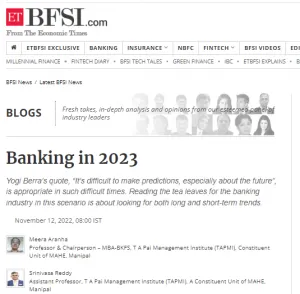Authors: Prof Meera Aranha and Srinivasa Reddy
Pageview– 4,268,335
The year 2023 has the prospects to be exciting for banks. With fintech investments waning and neo-banks experiencing their fair share of difficulties, traditional banks can breathe a sigh of relief and formulate strategies after understanding the trends. War, failing supply chains, and the collapse of Credit Suisse’s investment banking and Goldman Sachs’ consumer divisions define 2022 thusfar. The global economic outlook is one of high inflation, with even middle-income nations such as Turkey experiencing difficulty. The IMF has projected a 2.7% global growth for 2023. Also, large economies like China are experiencing challenging economic conditions, such as a contraction in the mortgage and housing markets. Yogi Berra’s quote, “It’s difficult to make predictions, especially about the future”, is appropriate in such difficult times. Reading the tea leaves for the banking industry in this scenario is about looking for both long and short-term trends.
Trends for banks
Cryptocurrency collapse: – The collapse of cryptocurrency values indicates that false hype is in the past and the market has assessed every crypto coin’s true value (zero). For several millennials, cryptocurrency was the new ‘Robin Hood’ shortcut to wealth. The party is over and the trend indicates that traditional asset classes, including equity and real estate property, would see a spike. Making it easy to invest in these classes is a task cut out for banks. Banks must dig deep into their product portfolio and create ‘appy products’ —products with a unique value proposition targeted at millennials to monitor financial behaviour and offer predictive wealth management solutions.
Artificial intelligence in banking operations: – Several back office and service operations, including customer-facing chat robots, credit decisions, advanced fraud detection, risk modelling, and regulatory compliance, are now utilising artificial intelligence. Several banks have partnered with fintech companies to enhance their AI operations, and the insights should be used to strengthen their franchises in 2023. While back-end implementations serve as test cases for AI, future use cases include Search Engine Optimisation (SEO), lead generation, and sales closing.
Mobile payments: – Mobile payments and UPI were game-changers for many fintech companies and played a significant role in transforming banks into plain transaction processors. Banks should step into creating ‘super apps’ (for example, Vietnamese MBbank successfully created a super-app) that create customer utility for an entire ecosystem. Identifying Internet niches that require unique solutions is the key to success in this transaction-based game. The key to differentiation would be to develop superior applications for various communities.
Central bank digital currency (CBDC): – The RBI intends to introduce the CBDC rupee. This solution could one day replace the existing UPI/NEFT payment infrastructure. The Chinese digital Yuan has already surpassed $14Bn in transactions while granting regulators access to transaction-level data. Consequently, this may represent a longer-term shift of big data from fintech/bank databases to central bank databases. CBDC adoption may be sluggish as existing customer bank savings accounts accrue interest. Customers would prefer to use UPI at the time of the transaction rather than hold an interest-free digital currency. However, RBI would need to develop use cases that go beyond replicating the excellent payment infrastructure that already exists. Allowing banks to escrow CBDC receipts from corporations would also reduce systemic default risks.
Adapt to changes in customer behaviour: – Fintech and internet-based portals have provided customers with a high level of service. Post-pandemic, customers have higher expectations from online and offline banking services. As rising inflation strains household budgets, banks must modify their service offerings and strive for a higher level of customisation. In addition, the success of platforms such as CRED demonstrates that if banks reward customer loyalty through data-driven solutions, customers will become more loyal.
NFT:- While Non-Fungible Token (NFT) values have plummeted, luxury customers continue to value premium experience-related NFTs. A recent article in the New York Times highlights the role of NFTs in the restaurant booking space. Offering customised NFTs as a loyalty reward for premium customers is a step in the right direction and a trend to watch for banks. NFT rewarding would permit monitoring and dynamic reassignment of rewards, thereby enhancing customer value.
Higher usage of credit :- As consumers struggle to manage their household budgets, personal credit, such as personal loans and credit cards, is on the rise. An increase in credit card delinquency prompted Goldman’s recent decision to reduce their consumer portfolio. If the delinquency rate on consumer loans and credit card portfolios rises over the next two to three years, boosting profitability will be difficult. More robust monitoring of consumer transactions and active reduction of outstanding cards could benefit banks whose cards occupy the third or fourth position in the consumer’s wallet.
Regulatory changes in response to the external environment:- Global economic trends include elevated central bank actions on inflation. The era of cheap money has ended, and the global economy is now experiencing turbulent times. In the United States, interest rate hikes have not been as effective as anticipated and there is talk of a recession as a solution to ineffective inflation targeting. This would undoubtedly impact developing economies like India, and the RBI’s approach to the economically sensitive dollar-to-INR exchange rate and interest rate outlook should be closely monitored. Indian policymakers should examine the actions of the Regulator during the complex financial crisis of 2008, from which India emerged unscathed. Focusing on domestic demand and increasing the amount of credit allocated to domestic infrastructure projects are two measures that can spur India’s growth in testing times.
Sustainability:- In the past year, ESG has received some negative press. Due to a high level of scepticism, the ESG category has performed poorly. However, banks must capture the momentum for sustainability. Utilising credit evaluations incorporating ESG impact– beyond the required EIA – is necessary. Better success on this metric would result from board-level engagement with key stakeholders.
While the aforementioned factors will drive 2023, trends such as the startup funding winter and the role of banks in venture financing, taking financial inclusion beyond Jan Dhan are other trends that bankers should note.
Link- https://bfsi.economictimes.indiatimes.com/blog/banking-in-2023/95459767









